Cliff Palace
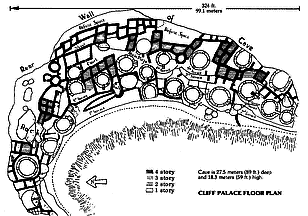
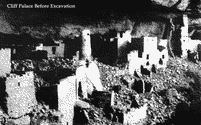


(1) On a snowy, wintry December 18th, 1888, two cowboys, Richard Wetherill and his brother-in-law Charlie Mason, were riding across the mesa top looking for stray cattle. At the edge of the pinyon and juniper forest surrounding them lay a vast canyon, the same one you can see from this overlook. The only difference is that they were across the canyon near Sun Temple. Through the blowing snow they could distinguish something in the cliffs which looked like "a magnificent city." These ranchers from the Mancos Valley east of the park were the first white men to see what they called "Cliff Palace." After further exploration, they entered the dwelling and made a small collection of artifacts before leaving for the day. In the next 18 years these same men, as well as various exploring parties and tourist groups, made expeditions into Mesa Verde. Many of them camped in the dwellings for days or weeks at a time while they were sightseeing or looking for cattle. Because there were no laws protecting such sites at the time, they often removed artifact collections or defaced certain sections of the ruin. Protection for the dwellings came with the establishment of Mesa Verde in 1906, yet it was not until 1909 that Jesse Walter Fewkes of the Smithsonian Institution excavated and first stablilized Cliff Palace.
Take a look at the alcove in which the dwelling is built. The rock you see is Cliff House sandstone, geologically deposited during the Cretaceous Period some 78 million years ago. Since sandstone is very porous material, moisture seeps right down through it. Beneath the layer of sandstone, however, is a layer of shale through which the moisture cannot penetrate. In the winter months, when the moisture freezes and expands, chunks of sandstone are cracked and loosened. Later these pieces collapse, forming alcoves such as the one here. The majority of alcoves are small crevices or ledges able to accommodate only a few small rooms. Very few are large enough to house a dwelling the size of Cliff Palace which contains 217 rooms and 23 kivas and had a population of 200-250 people. This is partially why out of the nearly 600 cliff dwellings concentrated within the boundaries of the park, 75% contain only 1-5 rooms each, and many are single-room storage units. You will be entering an exceptionally large dwelling which may have had special significance even for the original occupants.
The people who lived in Mesa Verde archeologists call the "Anasazi," a Navajo Indian word meaning "ancient ones" or "ancient foreigners." The Anasazi had no association with the modern day Navajo people. We use a Navajo word to refer to them because we don't know what these early inhabitants called themselves. They moved up onto the mesa somewhere around A.D. 500. Although they used the cliff alcoves consistently throughout the time that they were in the area, they did not build the cliff dwellings as such until around A.D. 1200. The dwellings represent a massive construction project, yet the Anasazi lived in them only about 75 to 100 years because by A.D. 1300 they had abandoned the area. As you walk through Cliff Palace, keep in mind that this structure continues to hold many secrets which the archeologists will never be able to unravel. For all of our advanced research and knowledge, we cannot answer certain basic questions about these ancient residents.
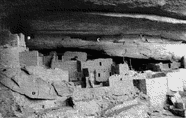 (2) From this vantage point take a minute to note the overall
features of Cliff Palace. (A) The upper ledge contains remnants
of 14 storage rooms ranging between 39 and 42 inches inches in
height (1 to 1.2 meters). (B) The Anasazi gained access to
these storage rooms by using a short ladder to the small
doorway on the far left. You can see two notches below the
doorway where the top of the ladder rested. Such storage rooms
may seem relatively inconvenient, yet they were quite practical
because they were cool, dry, and out of the way of children and
domesticated dogs and turkeys. (C) Since this wall section was
made using only carefully stacked rocks without mortar, it is
known as "dry wall." Perhaps the Anasazi built it during a time
when water scarcity prevented the use of mortar, or it may have
been built as an emergency repair procedure. (D) In 1934 the
National Park Service stabilized the area around the large
boulder which contains several vertical cracks. This section
has been reinforced with over 70 tons (6360 kilos) of steel and
concrete, hidden by the wall beneath the
boulder. (E) Prehistoric masonry was found beneath the boulder
during stabilization. Obviously, the Anasazi were also
concerned with keeping this rock in place.
(2) From this vantage point take a minute to note the overall
features of Cliff Palace. (A) The upper ledge contains remnants
of 14 storage rooms ranging between 39 and 42 inches inches in
height (1 to 1.2 meters). (B) The Anasazi gained access to
these storage rooms by using a short ladder to the small
doorway on the far left. You can see two notches below the
doorway where the top of the ladder rested. Such storage rooms
may seem relatively inconvenient, yet they were quite practical
because they were cool, dry, and out of the way of children and
domesticated dogs and turkeys. (C) Since this wall section was
made using only carefully stacked rocks without mortar, it is
known as "dry wall." Perhaps the Anasazi built it during a time
when water scarcity prevented the use of mortar, or it may have
been built as an emergency repair procedure. (D) In 1934 the
National Park Service stabilized the area around the large
boulder which contains several vertical cracks. This section
has been reinforced with over 70 tons (6360 kilos) of steel and
concrete, hidden by the wall beneath the
boulder. (E) Prehistoric masonry was found beneath the boulder
during stabilization. Obviously, the Anasazi were also
concerned with keeping this rock in place.
Doorways in the cliff dwellings were probably built deliberately small to keep out the cold air and draft of the winter months. At such times, the Anasazi covered them with rectangular sandstone slabs about an inch thick. During the summer months, they placed willow mats, skins or hides over the doorways just for privacy. Often people look at the size of these doorways and wonder about the size of the Anasazi. An average man was about 5'4" to 5'5" tall, while an average woman was 5' to 5'1". If you compared them with the European people of the same time period, they would have been about the same size. Their average life span was fairly short. Most people lived only 32-34 years. Some people would have lived longer, but the infant mortality rate was high since about 50¡%of the children died before they reached the age of 5.
As you can see, the main construction material was sandstone. The Anasazi chipped and pecked the sandstone with harder, riverbed stones which acted like hammerstones. The mortar between the blocks is a mud and water mixture. Fitted in the mortar are tiny pieces of stone called "chinking" stones which fill in the gaps and help prevent the walls from collapsing any sooner than they normally would. Over the top, the Anasazi placed a thin coating of plaster which was the first thing that eroded away as time passed. If you look closely at the area below and to the left of point (B), you can see the original pinkish-brown plaster. It gives you an idea of how brightly colored and well-finished the dwelling must have looked in the 1200's.
Residents of Cliff Palace carried water to the dwelling from several nearby springs. Although there is a small seep located near the entrance, it is doubtful that it supplied enough water for all of the people who lived here. The closest spring today is across the canyon below Sun Temple.
(3) The entire talus slope in front of Cliff Palace, including what is now the trail, served as a refuse or trash heap. Materials such as broken pottery, bone or stone tools, discarded yucca fiber sandals, worn out clothing, cold ashes from fires, human wastes, and a variety of corn cobs, squash and other food were all thrown in this area. Archeological excavators sift through these trash heaps in an attempt to locate materials for reconstructing information about the daily practices of the Anasazi. These trash slopes enable them to answer many questions that would otherwise remain a mystery.
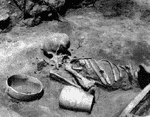 The Anasazi commonly buried their dead in this refuse
area. This practice had nothing to do with any dishonor or
disrespect; the loose material was probably much easier to dig
than the surrounding ground, especially during the winter months
when it was frozen. The body was usually buried in a flexed
position with the knees drawn up to the chest and wrapped in a
yucca fiber mat, rabbit fur robe or turkey feather
The Anasazi commonly buried their dead in this refuse
area. This practice had nothing to do with any dishonor or
disrespect; the loose material was probably much easier to dig
than the surrounding ground, especially during the winter months
when it was frozen. The body was usually buried in a flexed
position with the knees drawn up to the chest and wrapped in a
yucca fiber mat, rabbit fur robe or turkey feather
 blanket. Objects such as pottery and tools, which might be
considered useful in the next life, were buried with the
individual. Jewelry and ornaments were other typical
possessions placed on the bodies. Because burials are found in
a variety of places and many of them could have been disturbed
or dug up by animals, we may never be able to account for the
number which should be found in Mesa Verde.
blanket. Objects such as pottery and tools, which might be
considered useful in the next life, were buried with the
individual. Jewelry and ornaments were other typical
possessions placed on the bodies. Because burials are found in
a variety of places and many of them could have been disturbed
or dug up by animals, we may never be able to account for the
number which should be found in Mesa Verde.
The natural floor of the alcove is very uneven. The Anasazi, who needed level work surfaces for construction purposes, built the front retaining walls and backfilled the area behind the rubble. As a result, there is often several feet of fill material serving as a foundation for living rooms, illustrating the amount of work that went into the construction of these dwellings.
 The wooden beams protruding from the base of the wall are
original timbers, some of the few remaining ones in Cliff
Palace. Although early explorers often used timbers for
firewood, even they commented about the lack of original wood
in this particular dwelling. The white corks extending into
these beams plug holes where archeologists took core samples
for dating when Cliff Palace was built. Because Douglas fir,
ponderosa pine, and pinyon pine trees form individual growth
The wooden beams protruding from the base of the wall are
original timbers, some of the few remaining ones in Cliff
Palace. Although early explorers often used timbers for
firewood, even they commented about the lack of original wood
in this particular dwelling. The white corks extending into
these beams plug holes where archeologists took core samples
for dating when Cliff Palace was built. Because Douglas fir,
ponderosa pine, and pinyon pine trees form individual growth
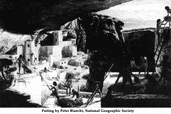 rings each year, tree ring dating provides very accurate records
of construction for cliff dwellings in the Southwest. Dates for
Cliff Palace extend from 1209 through the early 1270's, showing
that some building was in progress throughout the time that
people lived here. As a family increased in size, the Anasazi
must have added on another room to accommodate the larger
group. You can see evidence of constant remodeling in doorways
that have been made smaller or blocked up, walls that have been
added or removed, and tracings on the cave ceiling where rooms
at one time existed.
rings each year, tree ring dating provides very accurate records
of construction for cliff dwellings in the Southwest. Dates for
Cliff Palace extend from 1209 through the early 1270's, showing
that some building was in progress throughout the time that
people lived here. As a family increased in size, the Anasazi
must have added on another room to accommodate the larger
group. You can see evidence of constant remodeling in doorways
that have been made smaller or blocked up, walls that have been
added or removed, and tracings on the cave ceiling where rooms
at one time existed.
(4) This large circular room is called a kiva (KEE-vah). Kiva
is a Hopi Indian word which means "ceremonial room." The Hopi
are Pueblo people who live in mesa top villages in northern
Arizona. Based upon what we can infer from modern Pueblo
practice, the Anasazi used these kivas for ceremonies as well
as work rooms and social gathering places. Evidence of loom
loops in the floors of many Mesa Verde kivas points to their
use for weaving also. Each kiva generally contained six pillars
or pilasters on the inside wall which helped support the roof
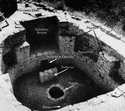 structure. The original roofs served as courtyards and
consisted of thick timbers, smaller poles, and a mud mixture
sturdy enough to support the weight of daily activities. The
benchlike shelf, or "banquette," on which the pilasters rest,
provided storage space for pottery and other objects. The
purpose of the recessed area on the south side of this kiva is
not known. Small, rectangular niches in the side wall of the
kiva were shelves where possibly turquoise, shell ornaments,
feathers, or other ceremonial objects could be kept.
structure. The original roofs served as courtyards and
consisted of thick timbers, smaller poles, and a mud mixture
sturdy enough to support the weight of daily activities. The
benchlike shelf, or "banquette," on which the pilasters rest,
provided storage space for pottery and other objects. The
purpose of the recessed area on the south side of this kiva is
not known. Small, rectangular niches in the side wall of the
kiva were shelves where possibly turquoise, shell ornaments,
feathers, or other ceremonial objects could be kept.
In the center of the kiva roof was a rectangular opening where a ladder provided access into the room. The base of the ladder usually rested near the firepit. The wall of stones adjacent to the firepit is known as a "deflector wall." When the Anasazi started a fire in the kiva, smoke rose through the roof hatchway. This created a partial vacuum in the room which drew fresh air down through the chimneylike ventilator shaft. The circulation of fresh air made an efficient ventilation system.
A typical feature of about 50% of all Mesa Verde kivas is the small hole in the floor between the firepit and the wall which is called a sipapu (SEE-pah-pooh), the symbolic entrance into the underworld. Some people refer to it as a spirit hole. The Hopi people consider that their ancestors emerged through several previous underground worlds, the entrance to each one of these worlds being an opening called a sipapu. The sipapu is a good example of a feature found not just in prehistoric kivas such as this one. It is also found in modern day kivas and is a belief that some of these people still hold.
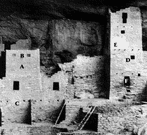 (A) Notice the extremely fine masonry of the original wall next
to this kiva. The Anasazi must have taken great pains to
construct such walls so straight and square off the corners so
well. (B) The two small openings near the top of this wall
were used for ventilation of the rooms that were behind
it. Many Anasazi living rooms were not well ventilated, and
smoke-blackening of the walls and roof were common. (C) The
holes below the rectangular doorway in this wall were sockets
for beams that supported the roots of the ground floor
(A) Notice the extremely fine masonry of the original wall next
to this kiva. The Anasazi must have taken great pains to
construct such walls so straight and square off the corners so
well. (B) The two small openings near the top of this wall
were used for ventilation of the rooms that were behind
it. Many Anasazi living rooms were not well ventilated, and
smoke-blackening of the walls and roof were common. (C) The
holes below the rectangular doorway in this wall were sockets
for beams that supported the roots of the ground floor
 rooms. Over the tops of the large beams the Anasazi placed
smaller poles, a layer of juniper bark, and a layer of mud 5 to
6 inches thick. As a result, the roofs were not only thick and
sturdy, they also allowed fires to be built in upper story
rooms. (D) This tower-like structure behind the kiva to the
south is one of the tallest sections of Cliff Palace. It would
have appeared more as an apartment house complex in the 1200's
with other walls surrounding the ones you now see. It has been
restored more than any other area in Cliff Palace. (E) When the
early cowboys discovered Cliff Palace, this corner of the tower
had collapsed, leaving a gaping hole all along this
side. Archeologists reconstructed the corner to support the
rooms. Over the tops of the large beams the Anasazi placed
smaller poles, a layer of juniper bark, and a layer of mud 5 to
6 inches thick. As a result, the roofs were not only thick and
sturdy, they also allowed fires to be built in upper story
rooms. (D) This tower-like structure behind the kiva to the
south is one of the tallest sections of Cliff Palace. It would
have appeared more as an apartment house complex in the 1200's
with other walls surrounding the ones you now see. It has been
restored more than any other area in Cliff Palace. (E) When the
early cowboys discovered Cliff Palace, this corner of the tower
had collapsed, leaving a gaping hole all along this
side. Archeologists reconstructed the corner to support the
 remaining walls and preserve the wall paintings on the
inside. (F) Look inside the door to see the size of the
room. Most living rooms average 6 feet by 8 feet (1.8 meters by
2.4 meters) and are about 5 ½ feet (1.7 meters)
high. Rectangular or T-shaped doorways led into these
rooms. Wall paintings such as the one here were not uncommon
for the Anasazi at all. They decorated their houses much as we
do today, but not much original plaster remains because it was
the first thing that eroded away as time passed after these
people left Cliff Palace. Colors were usually earth tones with
off-white and reddish-brown the most common in Mesa Verde.
remaining walls and preserve the wall paintings on the
inside. (F) Look inside the door to see the size of the
room. Most living rooms average 6 feet by 8 feet (1.8 meters by
2.4 meters) and are about 5 ½ feet (1.7 meters)
high. Rectangular or T-shaped doorways led into these
rooms. Wall paintings such as the one here were not uncommon
for the Anasazi at all. They decorated their houses much as we
do today, but not much original plaster remains because it was
the first thing that eroded away as time passed after these
people left Cliff Palace. Colors were usually earth tones with
off-white and reddish-brown the most common in Mesa Verde.
(5) The two southern kivas toward the end of the alcove are
joined by a tunnel. Another tunnel leads from the southernmost
kiva into one of the rooms behind it. (This tunnel has been
blocked up for reasons of safety.) Although most kivas have
only a central entrance in the roof, some do have side tunnel
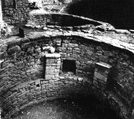 entrances such as you see here. Perhaps they were used
theatrically for sudden appearances or disappearances during
ceremonies. Modern Pueblo people initiate children into the kiva
societies and sometimes use theatrical devices as part of the
initiation rite. You can imagine the effect such devices would
have on 8 or 9 year old children.
entrances such as you see here. Perhaps they were used
theatrically for sudden appearances or disappearances during
ceremonies. Modern Pueblo people initiate children into the kiva
societies and sometimes use theatrical devices as part of the
initiation rite. You can imagine the effect such devices would
have on 8 or 9 year old children.
As you start to the top of the mesa on the exit trail, look to
your right approximately 15 feet (about 3.5 meters) below the
first ladder you will see. There on the cliff face you will
notice shallow niches carved into the sandstone by the
Anasazi. This is a typical hand and toe hold trail which these
people used for access to Cliff Palace. Each notch would
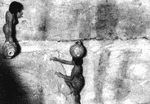 accommodate no more than the tips of the fingers or ends of the
toes, and weathering over the centuries has worn them down
considerably. Imagine the Anasazi carrying burdens on their
backs or vessels on their heads while ascending or descending
these trails. You have to marvel at their adeptness and agility
in scaling these cliffs on a daily basis. Hand and toe hold
trails like these are found throughout the Mesa Verde
area. Some of them are not only precarious, they are even
coded. You had to start climbing with a specific foot toward
the top. Otherwise, halfway up a cliff face you would have to
cross feet and regain your balance. One mistake could be your
last!
accommodate no more than the tips of the fingers or ends of the
toes, and weathering over the centuries has worn them down
considerably. Imagine the Anasazi carrying burdens on their
backs or vessels on their heads while ascending or descending
these trails. You have to marvel at their adeptness and agility
in scaling these cliffs on a daily basis. Hand and toe hold
trails like these are found throughout the Mesa Verde
area. Some of them are not only precarious, they are even
coded. You had to start climbing with a specific foot toward
the top. Otherwise, halfway up a cliff face you would have to
cross feet and regain your balance. One mistake could be your
last!
By A.D. 1300 Mesa Verde had been completely abandoned, as was the entire Four Corners region. Probably a number of factors caused the Anasazi to leave here. Although there was a severe drought from A.D. 1276 to 1299, these people had survived earlier droughts which were more severe. A lack of water could not have been the only problem that forced all of the Anasazi to move. After several hundred years of intensive use, soil, timber, and wildlife resources must have been depleted by the late 1200's, causing scarcity and possible internal strife. There is even some recent research concerning a general cooling off period at around that time which may have shortened the growing season enough that the Anasazi were no longer successful in their farming efforts. A combination of such difficulties all happening at the same time may have had a devastating influence on the entire population, forcing them to leave their cherished homes.
Anthropologists believe that the people gradually moved south, intermarried, and were incorporated into different villages scattered across northern Arizona and New Mexico. Today if you visit the Hopi mesas in Arizona, or Zuni, Acoma, Santo Dominto, San Felipe, or other Rio Grande Pueblos near Santa Fe, New Mexico, you would find some of the descendents of the Mesa Verde Anasazi.
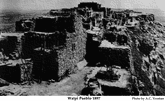
Index